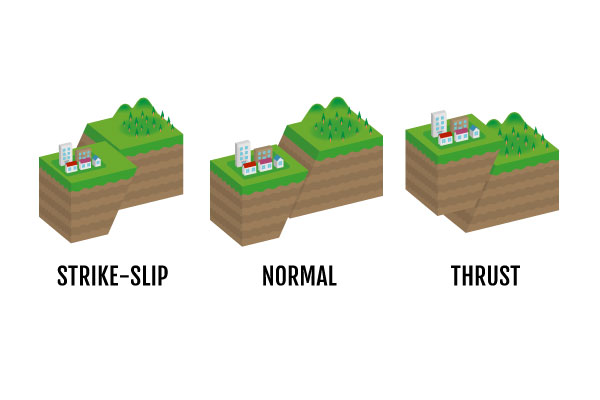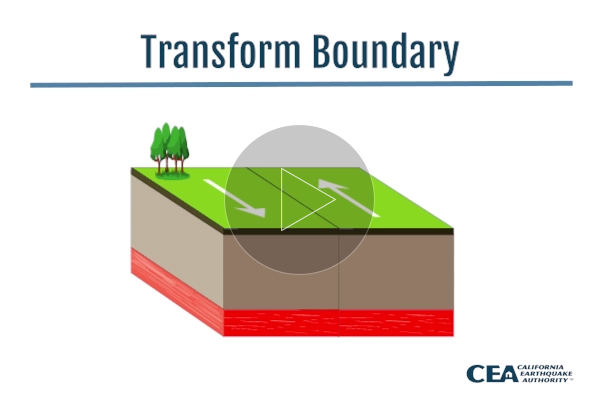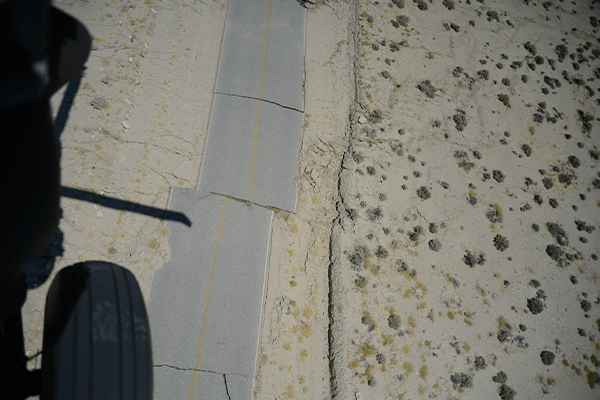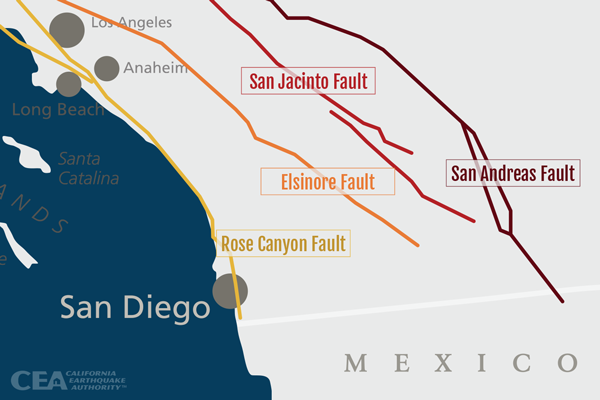What is a fault?
Despite its natural beauty, abundant sunshine, majestic mountains, plentiful agriculture, and proximity to the Pacific Ocean, California, from a geologic standpoint, is far from perfect. From the Golden State’s urban cities to scenic coastal areas, most of us live within 30 miles of a fault, which can best be described as a crack or fracture between two blocks of rock in the Earth’s crust. The sudden, rapid movement of these blocks of rock is what leads to earthquakes.
A fault is a “weak point within a tectonic plate where pressure from the Earth’s surface can break through and cause shaking in an earthquake.” Faults vary in length and seldom follow a straight line.
The United States Geological Survey (USGS) explains that “faults allow the blocks (of rock) to move relative to each other. This movement may occur rapidly in the form of an earthquake—or may occur slowly, in the form of creep. During an earthquake, the rock on one side of the fault suddenly slips with respect to the other.”
There can be confusion over the difference between what is a fault and what is a fault line. A fault line, sometimes also known as a fault trace, is where a fault can be mapped or observed on the surface. A fault line often is plotted on earth sciences maps to represent a fault.
An earthquake hazards map, such as this one on the USGS website, provides seismic hazards mapping information to help you become more familiar with the earthquake hazards in the specific area in which you live.
What are the main types of faults?
While California’s 15,700 faults might sound like a lot, there are thousands upon thousands of different types of earthquake faults and different types of fault lines as part of the North American Plate and other plate boundaries around the world. The Earth’s faults can be broken down into a few main categories or types of faulting depending on their movement. Scientists use the angle of the fault in relation to the surface (known as the dip angle) and the direction of fault slips to classify the different types of faults in geology.
The USGS describes some of the different types of faults below. The USGS notes that its definitions of these faults are adapted from the book, The Earth, by Frank Press and Raymond Siever.
Normal Fault
A normal fault is the most common type of fault. Normal faults are dip-slip faults that move downward in relation to the blocks of rock below. In normal faults, the faulting occurs when blocks of rocks slip past one another. Normal faults are common in the western United States, in mountain ranges and along ocean ridges.
Reverse Thrust Fault
A reverse thrust fault is also known as a dip-slip fault. But it differs from a normal fault in that it moves upward in relation to the block of rocks below. The USGS notes that these types of faults are common in Japan. A reverse fault is sometimes called a thrust fault if the dip angle of the fault is shallow.
Both the destructive magnitude 6.7 San Fernando/Sylmar earthquake in 1971 and the deadly magnitude 6.7 Northridge quake in 1994 occurred on thrust faults, according to the Southern California Earthquake Center.
Strike-Slip Fault
If you live in California, you probably have heard of the notorious San Andreas fault, which cuts through a wide swath of the Golden State. The San Andreas fault is an example of strike-slip motion, in which faulting occurs when blocks of rock slide past one another horizontally. Strike-slip faults also are found in the Rocky Mountains. Another example of a strike-slip fault is the Garlock fault, which triggered the magnitude 7.1 Ridgecrest earthquake in 2019. According to the USGS, the recent magnitude 6.4 earthquake on December 20, 2022 near Ferndale in Humboldt County was the result of strike-slip faulting.
Transform fault
A transform fault, as shown below, is situated along a plate boundary where the movement and motion are mostly horizontal. Encyclopedia Britannica further defines a transform fault as a type of fault in which two tectonic plates slide past one another.
Left-Lateral Strike-Slip Fault
The USGS explains the difference between a left-lateral strike-slip fault and a right-lateral strike-slip fault, stating that when viewed from either side, the left-lateral strike-slip fault’s far rock block moves to the left. The above-mentioned Garlock fault is a left-lateral strike-slip fault.
Renowned earthquake scientist, Dr. Lucy Jones tweeted recently that a small, Southern California earthquake in September 2022, called the Mira Loma earthquake, appeared to be a left-lateral fault. “Today’s Mira Loma quake is a very standard SoCal quake. It’s in the Fontana trend- a lineation of quakes running SW from San Bernardino. We think it is a left-lateral fault covered by sediments,” Dr. Jones tweeted at 10:57 a.m. September 3, 2022.
Right-Lateral Strike-Slip Fault
Conversely, right-lateral strike-slip faults are ones that when viewed from either side, the far rock block moves to the right, according to USGS. The devastating, magnitude 6.9 Loma Prieta earthquake during Major League Baseball’s World Series in 1989 was triggered by the San Andreas fault, which is an example of a right-lateral strike-slip fault, according to National Geographic. The Bay Area’s other major fault, the Hayward fault, is another example of a right-lateral strike-slip fault.
Oblique-Slip Fault
According to the website, seismicresilience.org.nz, oblique-slip faults include the characteristics of strike-slip faults, which are known for the lateral direction of their movement, and dip-slip faults, which tend to move in a vertical direction.
In learning about the various type of faults, you might come across the words hanging wall and footwall. According to Elizabeth Johnson in the book Physical Geology Laboratory, in a dip-slip fault system, the footwall of the fault is below the fault plane and hanging wall of the fault is above the fault plane.
How are faults formed?
Different kinds of faults are formed in different ways, but they all occur when “rocks break due to forces acting on them.” According to the California Academy of Sciences:
Normal faults are formed “when rock above an inclined fracture plane moves downward, sliding along the rock on the other side of the fracture.”
Strike Slip faults are formed “when the blocks of rock on either side of a vertical (or nearly vertical) fracture move past each other.”
Reverse faults are formed “when the rocks on the ‘uphill’ side of an inclined fault plane rise above the rocks on the other side.”
Fault line cracks vary in size with some small and barely noticeable, while others are hundreds of miles long, such the San Andreas fault.
How do faults create earthquakes?
According to the USGS, the friction across the surface of the fault holds the rocks together so they do not slip immediately when pushed sideways. Eventually, however, enough stress builds up and the rocks on one side can slip, releasing energy in waves that travel through the rock and the fault to cause the shaking that is felt during an earthquake.
What are the major fault lines in California?
There are hundreds of known faults and fault lines in California. Several faults have even become household names, such as the San Andreas fault, the Hayward fault, the Rose Canyon fault, and the Puente Hills fault. It is important to keep in mind that faults in California are so numerous that not all of them are even known. The magnitude 6.7 Northridge earthquake in 1994 occurred on a thrust fault that was unknown at the time.
While it’s important to be aware of the faults crisscrossing California and the danger they pose when they trigger earthquakes, it’s equally important to understand the impact they can have on the lives and livelihoods of all Californians.
Having a better understanding of the San Andreas fault and other major Golden State faults is big step in the right direction when it comes to being better prepared for when the next major earthquake strikes.
How to prepare for an earthquake in California
As stated above, a good first step in preparing for the next major earthquake in California is to have some knowledge of the hundreds of faults that crisscross the Golden State. An equally important second step is to make sure your house is resilient enough to withstand the strong shaking that accompanies a major shaker.
Find out more about the importance of seismic retrofitting and how to strengthen your home. By doing so, you will help ensure your family is better protected when the next big earthquake strikes. After all, with the multitude of faults in the Golden State, it is not a matter of if, but when, the next major trembler will strike.




